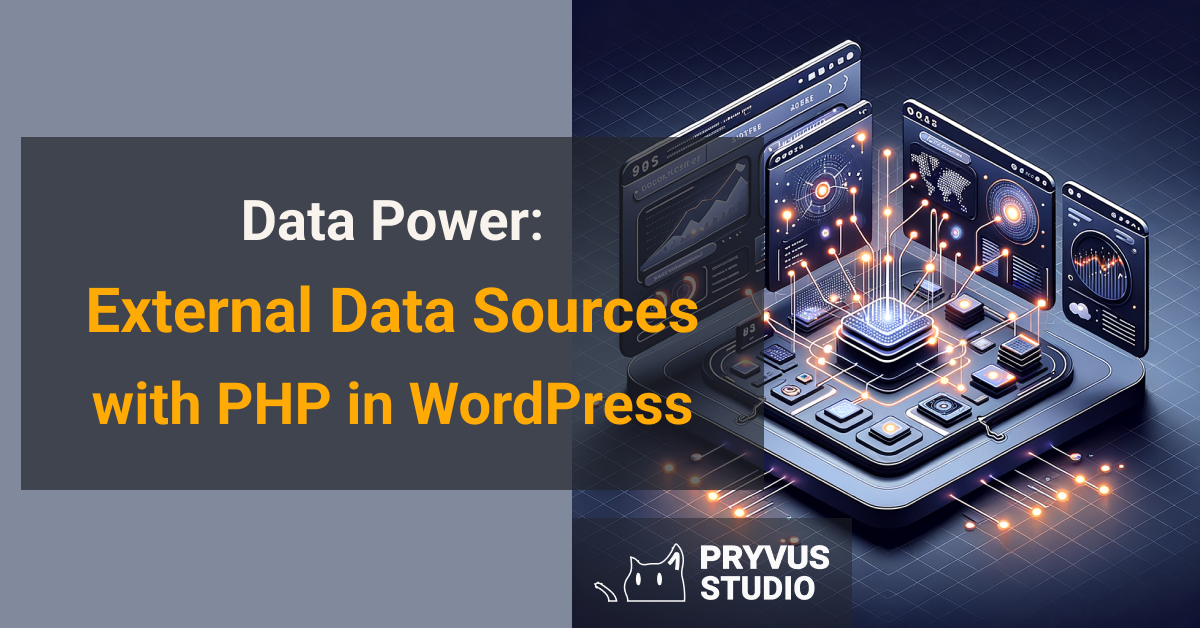Notice: Only variables should be passed by reference in /home/ploi/pryvus.com/public/wp-content/themes/pryvus/template-parts/content-post.php on line 12

Integrating external data sources with PHP in WordPress is a game-changer.
This approach not only enhances your website’s functionality but also personalizes the user experience, supporting informed decision-making. It’s the key to turning your WordPress site into a dynamic, data-driven platform.
In this article, you will learn:
- How to enhance your site with external data
- Steps for seamless data integration
- Ways to troubleshoot common issues
Data Power: External Data Sources with PHP in WordPress
Imagine your WordPress site, powered up with real-time data from external sources. Sounds cool, right? Pryvus Studio has been at the forefront of custom software development, including innovative solutions in web and mobile development. One area where we excel is integrating external data sources with PHP in WordPress. This not only enhances your site’s functionality but also opens up a myriad of possibilities for data-driven decision-making.
Integrating external data sources with PHP in WordPress can transform your website into a dynamic, data-driven powerhouse.
But why bother with external data? Well, it allows you to display up-to-the-minute information, offer personalized user experiences, and much more. For businesses, this means staying ahead of the competition by providing users with what they want, when they want it.
Let’s dive into how you can harness the power of external data. First, you need to understand what kind of data you’re looking to integrate. Are we talking about social media feeds, stock market updates, weather forecasts, or something else? The possibilities are virtually endless. Once you’ve nailed down the type of data, the next step is figuring out how to fetch it. This is where PHP comes into play.
PHP, a server-side scripting language, is incredibly versatile and a staple in WordPress development. It’s what you’ll use to request data from external sources, process it, and then display it on your site. But how do you actually make this happen? You’ll need to write custom PHP code that makes use of WordPress’s built-in functions and possibly some advanced PHP libraries.
For instance, you might use the wp_remote_get() function to fetch data from an API. Or, you might tap into the power of cURL, a tool that allows you to send and receive data via URLs. Handling the data once it’s received is another critical step. You might need to parse JSON or XML data, transform it, and then save it to your WordPress database or display it directly on your site.
Of course, integrating external data is not without its challenges. You’ll need to consider issues like data security, caching to improve performance, and how to handle data updates. But don’t let that put you off. The benefits far outweigh the complexities. And remember, Pryvus Studio is here to help if you need it.
To wrap up, integrating external data sources with PHP in WordPress is a game-changer. It enables your site to serve fresh, personalized content, directly impacting user engagement and business growth. Ready to get started? Dive deeper into the specifics with our step-by-step guide in the next section.
The Benefits of Integrating External Data into Your WordPress Site
Imagine elevating your WordPress site’s value by harnessing the power of external data. It’s not just about displaying data; it’s about enriching user experience and making informed business decisions. External data integration opens a world of possibilities, from enhancing content relevancy to optimizing operational efficiency.
Integrating external data can significantly elevate your WordPress site’s functionality and user engagement.

First off, it boosts content dynamism. Your site can display live data feeds, keeping content fresh and engaging. Think stock market tickers, weather updates, or even real-time social media streams. This constant refresh of information keeps users coming back for more.
Next, it personalizes user experience. By leveraging data like user preferences or location, you can tailor content, making it more relevant and engaging. Imagine a travel blog that offers weather forecasts and event recommendations based on the user’s current location or a retail site displaying products based on browsing history.
Moreover, integrating external data supports data-driven decision-making. Access to real-time market trends, customer feedback, or social media sentiments can inform your business strategies, helping you stay ahead of the curve.
However, it’s not all smooth sailing. Challenges like ensuring data security, maintaining site performance, and achieving seamless integration require careful consideration. But with the right expertise, like that offered by Pryvus Studio, these hurdles can be effectively managed, unlocking the full potential of external data in your WordPress site.
Step-by-Step Guide: Connecting to External Data Sources
Integrating external data into your WordPress site can seem daunting. Yet, it’s a powerful way to enhance your site’s functionality. Let’s break it down into manageable steps.
The key to successfully integrating external data with PHP in WordPress lies in a systematic, step-by-step approach.
First, identify the external data source you want to connect to. This could be a social media feed, a financial market update, or any other API offering valuable data for your site.
Next, evaluate the data source’s API documentation. Understanding the API’s capabilities and limitations is crucial for a smooth integration process.
Now, it’s time to write your PHP script. Use PHP’s curl functions to make requests to the API. Ensure your script can handle errors gracefully and parse the API’s response effectively.
Then, test your integration thoroughly. Check for any potential security vulnerabilities or performance issues that could impact your site.
Finally, deploy your integration. Monitor its performance and be prepared to troubleshoot any issues that arise.
Remember, integrating external data sources can unlock new opportunities for your business. It allows you to offer dynamic, personalized content that can significantly enhance user engagement.
However, challenges like data security and optimizing for performance are not to be overlooked. Pryvus Studio, with its vast experience in custom software development, can guide you through these challenges, ensuring a seamless integration process.
Troubleshooting Common Issues in Data Integration
When integrating external data with PHP in WordPress, obstacles are inevitable. Understanding how to navigate these challenges is crucial for maintaining a seamless user experience and data integrity. Let’s dive into common issues and how to troubleshoot them.
Effective troubleshooting in data integration significantly enhances site reliability and user trust.

Data Security Concerns
Data breaches can tarnish your website’s reputation overnight. To mitigate risks, ensure all data transmissions are encrypted using SSL. Regularly update your PHP scripts to patch any security vulnerabilities.
Performance Optimization
Fetching data from external sources can slow down your site. Cache external data when possible and optimize your database queries. Consider using a content delivery network (CDN) to reduce load times.
Data Consistency
External data changes. Ensure your site reflects these updates without manual intervention. Implementing automated update checks can keep your data fresh and relevant.
Handling API Limitations
APIs often have request limits. Efficiently use API calls by aggregating data requests and using server-side processing to minimize direct calls from your WordPress site.
By addressing these common issues, you can ensure a robust integration of external data sources with PHP in WordPress. Remember, Pryvus Studio’s expertise in custom software development can guide you through these challenges, ensuring your project’s success.
Leveraging External Data for Business Growth
When you tap into the power of external data sources with PHP in WordPress, you’re not just enhancing your website; you’re setting the stage for significant business growth. This strategy opens up a world of opportunities for personalized marketing, improved customer experiences, and data-driven decisions that can propel your business forward.
Using external data sources effectively can transform your WordPress site into a powerhouse for business intelligence and customer engagement.
But how exactly does one leverage this data for growth? Let’s dive in.
Understanding Your Audience
First off, integrating external data allows you to gain a deeper understanding of your audience. By analyzing user interactions and preferences, you can tailor your content, products, and services to meet their needs more precisely. This level of personalization not only enhances user experience but also boosts engagement and conversion rates.
Enhancing Decision Making
Next, external data provides valuable insights that aid in strategic decision-making. Market trends, consumer behavior analytics, and competitor analysis are just a fingertip away. These insights enable businesses to make informed decisions, identify new opportunities, and stay ahead of the competition.
Improving Product and Service Offerings
Furthermore, by integrating external data, companies can refine their product and service offerings. Real-time feedback and trends analysis help in understanding what works and what doesn’t, allowing for rapid adjustments and innovations. This agility can be a significant competitive advantage.
Streamlining Operations
Operational efficiency is another area where external data can make a big difference. From supply chain logistics to customer service enhancements, data-driven strategies can streamline processes, reduce costs, and improve overall efficiency. This not only benefits the bottom line but also improves customer satisfaction.
In conclusion, leveraging external data through PHP in WordPress is a powerful strategy for business growth. It enables a deeper understanding of your audience, enhances decision-making, improves offerings, and streamlines operations. With the right approach and expertise, such as that offered by Pryvus Studio, businesses can harness this power to achieve remarkable growth.
The Future of Data Integration in WordPress
Looking ahead, the integration of external data sources with PHP in WordPress promises to revolutionize how we interact with websites. It’s not just about displaying information anymore; it’s about creating interactive, dynamic experiences that cater to the user’s needs and preferences. Imagine a site that adapts in real-time to the user’s behavior, offering personalized content and recommendations.
But let’s break it down:
- Enhanced User Experience: Tailored content leads to higher engagement and satisfaction.
- Improved Decision-Making: Access to real-time data aids in making informed decisions.
- Increased Efficiency: Automated data processes save time and resources.
Of course, challenges like ensuring data security and optimizing performance will persist. However, with advancements in technology and expertise from companies like Pryvus Studio, these hurdles become manageable. The focus shifts from overcoming challenges to maximizing opportunities.
As we move forward, the key will be to stay innovative, adaptable, and always user-focused. The potential for business growth and enhanced user engagement is vast. It’s an exciting time for WordPress developers and site owners alike.
Feeling overwhelmed? Don’t be. Pryvus Studio is here to guide you through every step of your data integration journey. Let’s unlock the full potential of your WordPress site together.


